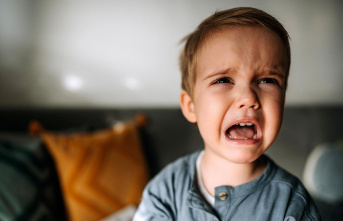Many children were happy about their first smartphone at Christmas, others are still waiting in vain for their own device. When is it too early for a tablet or smartphone, how can parents explore this new world together with their offspring and how important is it to be a role model? Anja Dinhopl, head of user experience research in the field of online safety and privacy for children and young people at the Google Safety Engineering Center (GSEC) in Munich, gave the spot on news news agency answers to these and other questions.
Anja Dinhopl: Basically, there is no perfect age for which the purchase of a smartphone is recommended. It all depends on how mature the child is and whether they are already able and willing to take on responsibility. If the child desires their own smartphone, it is best for parents to first ask why a device is important for the child? In addition to standard answers such as "Because everyone has one," guardians can try to elicit specific reasons and the desired purpose from the child. What would it do with your own smartphone? Would the device actually help in everyday life?
At this point, it is also advisable to talk about the expectations and responsibilities associated with a smartphone, for example. The child should be made aware of what a new device costs and what happens if it breaks. In addition, parents can also show what a data plan or app purchases are - so children understand that digital activities also have an impact on real life. If parents don't already have a sense of whether it's the right time for their first smartphone, the questions above can help to gain certainty.
Dinhopl: I recommend that parents set rules for dealing with digital media and end devices together with their children. It is important that children do not have to deal with the device on their own after receiving the smartphone or tablet. Discovering together is an important factor here, and it is important for parents to signal an interest in media education. The key is always the family exchange about possible risks or inappropriate content - and that goes beyond the initial period.
I like to offer three points that can help keep track of the content children are consuming: child, context, and content. The first is about assessing what content your child can already understand. Parents usually have a feeling for this. The context should also be questioned: are the parents present when the media is being used or is the child alone with a digital device? The third point covers the concrete content that the child consumes. Is it more games or videos? When choosing apps, parents should make sure that they are age-appropriate. An exchange on passwords and with which parties the device is used to communicate is also useful."
Dinhopl: At the Google Safety Engineering Center, we talk to children and young people as part of our research and answer questions like "What does Google do with the data?" or "Are cookies safe?". In group discussions, we found out that children and young people need clear and explicit answers when it comes to data protection questions. They should therefore be age-appropriate, understandable and, above all, as short as possible and, ideally, be presented visually. [...] Here, too, the following applies: the joint exchange has top priority.
For example, parents can ask their child what they think are positive ways to spend time online and why? Are there websites, apps or videos that were used to learn new things? Who inspired the child or brought them into contact with other people? Conversely, it should also be discussed which content is rated as not so positive and why. Here parents can specifically address certain platforms or websites and also videos - for example: Which videos should you watch and which shouldn't?
For some things, however, children first have to develop a feeling for themselves. In order to playfully integrate the positive benefits of the technology, families can, for example, set themselves the task of learning something new every day using the device for a week. Be it something historical, interesting facts about our planet or a fun fact about a film. At the end of the week we talk about what everyone was able to learn or what was perhaps particularly surprising. Of course, the age of the child is always an important factor in all of this, the older the children get, the more difficult it is to classify the use of the device. Parents should be flexible here and talk to the child about how they use the device or the content - over time, parents will get a better feel for it and be able to make more conscious decisions.
In addition to the content consumed, responsible use also includes the duration and context in which the device is used. In order to regulate the times and fix common "offline times", places can be defined that are device-free - for example the dining room. For this purpose, a box can be made together with the children in which, for example, the smartphone can be kept during the meal. There are no limits for the fanatasy.
Dinhopl: It makes sense when parents show interest in their children's online activities and offer themselves as a person of trust. With apps and games in particular, it is important that they are age-appropriate and that children do not consume any inappropriate content. Here, too, it is advisable to talk about it openly and perhaps also to explain that they are not yet old enough for certain applications.
Dinhopl: The role model function of the parents should not be underestimated. Children learn a great deal through observation and imitation. Parents should therefore be aware of their role model role. If you don't want your children to be constantly busy with their smartphones, you shouldn't set an example yourself. It helps to deal with your own digital media behavior and device usage. Is there anything that could be changed to set a good example for the child?
Dinhopl: Digital competence and media education play a major role. Parents should inform children as best they can about risks on the Internet. Even if they seem harmless, these risks can potentially pose a danger. For example, I would like to point out sensitive content that children are confronted with on the Internet. Children often have difficulty assessing whether this content is age-appropriate and trustworthy. This is why it is so important to have an open discussion with parents or persons you trust.
Digital skills development also includes talking to children about the behavior of other users. For example, bullying or discrimination online can take completely different forms.
Phishing is also something children may have little experience with - it needs to be discussed with them. In particular, where, how and to whom one discloses personal information, and above all which websites, links and emails one should not click on. Children need support here.
In our research at the Google Safety Engineering Center in Munich, we are primarily concerned with making digital competence in the areas of privacy and online safety understandable to children - what happens to personal data on the Internet? Which settings should you choose or when is my account as safe as possible?
The expert refers to a guide for families that she and her team at GSEC created. Among other things, this should help to find the right content for children and also give tips on dealing with social media and games. In addition, Google also offers a data protection guide for children and young people, which can help parents answer relevant questions.
In addition, the use of certain tools such as Google Family Link "can be very helpful in helping children and young people to find a good balance between online and offline activities by allowing parents to set screen times, among other things," explains Dinhopl. For example, the security settings for a child's account or apps on the device can be managed. "Such apps should not be used to monitor online usage behavior, but to create a good basis for discussion," explains the expert, adding: "Parents can find out, for example, which apps are exciting for the children to Then talk to them about it. Luckily, the range of safe media education is now quite large."
Such features are not limited to Google's Pixel smartphones or other Android devices. Apple customers can also use corresponding features on the iPhone or iPad, for example to limit screen time or the purchase of apps and to block in-app purchases, for example.












